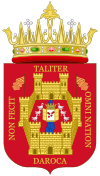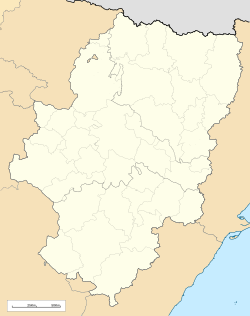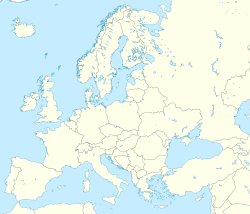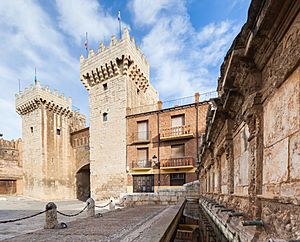Daroca facts for kids
Quick facts for kids
Daroca
|
|||
|---|---|---|---|
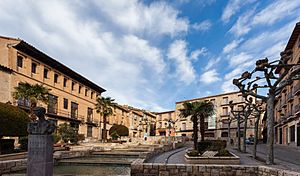 |
|||
|
|||
| Country | |||
| Autonomous community | |||
| Province | Zaragoza | ||
| Comarca | Campo de Daroca | ||
| Area | |||
| • Total | 52.05 km2 (20.10 sq mi) | ||
| Elevation | 782 m (2,566 ft) | ||
| Population
(2018)
|
|||
| • Total | 1,996 | ||
| • Density | 38.348/km2 (99.32/sq mi) | ||
| Demonym(s) | Darocenses | ||
| Time zone | UTC+1 (CET) | ||
| • Summer (DST) | UTC+2 (CEST) | ||
| Postal code |
50360
|
||
Daroca is a historic city and a local government area (called a municipality) in Aragon, Spain. It's located south of the big city of Zaragoza. Daroca is an important center for its local area.
The city sits in a valley by the Jiloca river. A main road, the N-234 highway, goes right through Daroca.
Contents
History of Daroca
Ancient Beginnings and Roman Times
Some historians believe that Daroca was first a village called Darek, built by the ancient Celtiberians. Later, the Romans arrived and called it Agiria. They built a strong castle to protect an important road that connected the cities of Zaragoza and Valencia.
Arab Rule and Reconquest
Around the year 862, the Arabs took control of the area and named the city Calat-Darawca. They ruled for about 400 years. In 1120, a Christian king named Alfonso the Battler conquered Daroca. Later, in 1141, he gave the city its first set of laws.
Daroca's Golden Age
In the 12th century, Ramon Berenguer IV gave Daroca special laws and rights. This made it the capital of the "Community of Daroca," which was a powerful group of towns and villages in the Middle Ages. Daroca had a say in important meetings (called courts) and hosted several famous gatherings of kings and nobles.
For example, in 1338, a peace agreement was made here with Castile. During a war against Peter of Castile, Daroca bravely defended itself from a siege (when an army surrounds a city to try and capture it). Because of its strong resistance, Daroca was officially given the title of "city" on April 26, 1366.
Life in the Medieval City
The city was run by a council. Important members included the justice, judge, and jurors. These officials were usually elected for one year. People in Daroca mainly worked in farming and raising animals. There were three main groups of people living in the city: Christians, Jews, and Muslims. They all had the same laws and rights, but they organized themselves separately.
Royal Visits and Conflicts
Daroca was a popular stop for kings and queens traveling through Spain. Famous rulers like the Catholic Monarchs, Charles I, and Philip II all visited the city.
However, Daroca also faced tough times. During the War of Spanish Succession, Daroca supported a different king than the one who eventually won. Because of this, the city was attacked and looted. This war ended nearly 600 years of Daroca running itself. New officials appointed by the king took over.
Later Wars and Modern Challenges
During the Peninsular War (when Napoleon's French troops invaded Spain), French soldiers entered Daroca in 1808. They destroyed parts of the city and stayed there to control the area. Daroca was finally freed in 1813.
In the 1800s, during the Carlist Wars, Daroca was briefly taken over by rebel forces several times. But the city always remained loyal to the Spanish monarchy.
In the mid-1800s, Daroca's economy got better thanks to successful farming. This helped trade and small businesses grow. A railway built in the early 1900s also boosted Daroca's trade. However, over time, the city found it hard to adapt to new industries and markets. Today, people are trying to bring back trade and encourage tourism. But farming is struggling because there aren't enough young people to continue growing traditional crops like grapes and vegetables.
Main Sights in Daroca
Daroca has many interesting places to visit:
- The Wall of Daroca: This impressive medieval wall is more than 4 kilometers (about 2.5 miles) long!
- Gates: You can see several old gates like Puerta Baja, Puerta Alta, Portal de Valencia, and Arrabal.
- Church of San Miguel
- Church of San Juan
- Church of Santo Domingo
- Basilica of Santa María de los Sagrados Corporales: This church is famous for a special event called a Eucharistic miracle that happened in 1239.
- Fountain of the twenty pipes
Climate
Daroca has a type of climate called "cold semi-arid." This means it doesn't get a lot of rain each year, but it has plenty of sunshine, especially in summer. Summers are hot, but the city's elevation (how high it is above sea level) makes them a bit milder. Winters are cool, but not extremely cold for this part of Spain.
Events
Daroca hosts several fun events throughout the year:
- Festival of Antique Music (August)
- Corpus (May–June)
- San Cristóbal (July 10)
- Medieval Market (Last weekend of July)
Twin towns
Daroca is twinned with:
See also
 In Spanish: Daroca para niños
In Spanish: Daroca para niños



